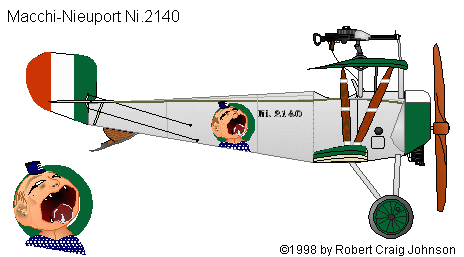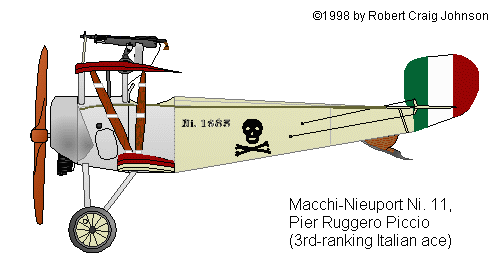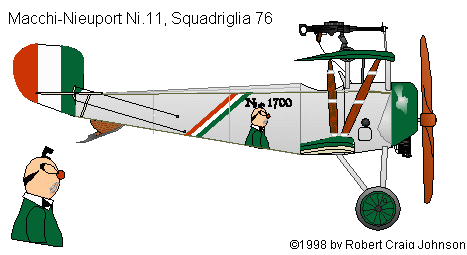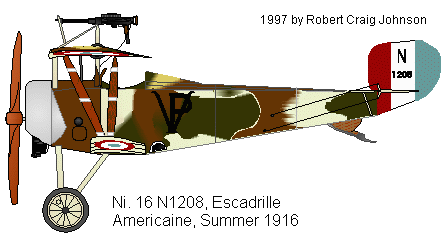Review:
Toko 1/72-scale Nieuport 11
injection-molded plastic,
decals. $7.98
The Nieuport 11 holds a place in the annals of WW1 air combat as the aircraft most
responsible for restoring air superiority to the Western Allies in 1916, the time of
the "Fokker Scourge." It is also the subject this, the fourth Toko kit this reviewer
has examined.
Certain dimensional anomalies in the kit substantially confirmed the suspicion that
most of Toko's releases so far have been based on drawings found in Fighter Aircraft
of the 1914-1918 War, first published by Harleyford Publications over 40 years ago.
 But this is not to say that this volume is the sole reference Toko used, nor can Toko be
blamed for any inaccuracies that may result. When the reviewer consulted a number of
other references on this aircraft, including recently published Datafile booklets
from Albatros Publications and copies of German and Italian drawings made from
original machines (generously provided by Michael Fletcher, publisher of the
Nieuports web page), he found enough
inconsistencies to conclude that mistakes exist in most available drawings, mistakes that
are naturally perpetuated in models produced from them. The plans in the Windsock Datafile
Special suggest that Toko's fuselage is too deep and clunky looking. The accuracy of the
wings is hard to determine. Nearly every modern drawing the reviewer examined shows
the upper mainplane with 5 wing ribs forward of the aileron, as does the kit part.
But drawings produced by Macchi, the Italian license-manufacturer for the type,
and photographs of Macchi-built machines show only 4 ribs on this part of the wing.
But this is not to say that this volume is the sole reference Toko used, nor can Toko be
blamed for any inaccuracies that may result. When the reviewer consulted a number of
other references on this aircraft, including recently published Datafile booklets
from Albatros Publications and copies of German and Italian drawings made from
original machines (generously provided by Michael Fletcher, publisher of the
Nieuports web page), he found enough
inconsistencies to conclude that mistakes exist in most available drawings, mistakes that
are naturally perpetuated in models produced from them. The plans in the Windsock Datafile
Special suggest that Toko's fuselage is too deep and clunky looking. The accuracy of the
wings is hard to determine. Nearly every modern drawing the reviewer examined shows
the upper mainplane with 5 wing ribs forward of the aileron, as does the kit part.
But drawings produced by Macchi, the Italian license-manufacturer for the type,
and photographs of Macchi-built machines show only 4 ribs on this part of the wing.
 Curiously, the color drawings in the Windsock Datafile Special show 4 ribs, while
the plans show 5. Both the Datafile Special and the Harleyford drawings suggest that
the kit's lower wing span is a full 5 mm short, something that would be difficult to fix.
The top wing span is also about 2 mm too short, though the chord seems to match that
of the Datafile plans. The Macchi plans suggest that the true wing spans may have
lain somewhere between those in the Datafile drawings and those in the kit. The
top wing center section seems to be well proportioned and the aileron-actuating bell cranks
seem to e correctly located. The propeller is badly proportioned, the blade chord
being much wider than period photographs indicate. Wheels are, on the other hand, beautiful.
These are the most accurate WW1 aircraft wheels Toko has yet produced.
Curiously, the color drawings in the Windsock Datafile Special show 4 ribs, while
the plans show 5. Both the Datafile Special and the Harleyford drawings suggest that
the kit's lower wing span is a full 5 mm short, something that would be difficult to fix.
The top wing span is also about 2 mm too short, though the chord seems to match that
of the Datafile plans. The Macchi plans suggest that the true wing spans may have
lain somewhere between those in the Datafile drawings and those in the kit. The
top wing center section seems to be well proportioned and the aileron-actuating bell cranks
seem to e correctly located. The propeller is badly proportioned, the blade chord
being much wider than period photographs indicate. Wheels are, on the other hand, beautiful.
These are the most accurate WW1 aircraft wheels Toko has yet produced.
 The kit is finely molded in the typical hard grey styrene found in all Toko kits. The wings are
well molded with very fine trailing edges. Molded-in internal framing is provided for the
cockpit interior, along with basic cockpit details, including a well-molded
seat, control stick, and rudder bar. The pilot's windscreen has a solid gray ridge where
the clear, square pane should be—a possibly difficult matter to correct. The kit includes some
nice LePrieur balloon-busting rockets for the interplane struts, but they exhibit mold lines
that will have to be carefully removed.
The kit is finely molded in the typical hard grey styrene found in all Toko kits. The wings are
well molded with very fine trailing edges. Molded-in internal framing is provided for the
cockpit interior, along with basic cockpit details, including a well-molded
seat, control stick, and rudder bar. The pilot's windscreen has a solid gray ridge where
the clear, square pane should be—a possibly difficult matter to correct. The kit includes some
nice LePrieur balloon-busting rockets for the interplane struts, but they exhibit mold lines
that will have to be carefully removed.
 The kit-supplied decals are quite interesting and almost worth the price
of the kit in themselves. Markings for 5 different aircraft are offered, two French,
two Russian, and one Ukrainian, from 1919. They are well printed and include many
fine stencils. This reviewer's only quibble was with the French cocardes. The
blue looks too dark.
The kit-supplied decals are quite interesting and almost worth the price
of the kit in themselves. Markings for 5 different aircraft are offered, two French,
two Russian, and one Ukrainian, from 1919. They are well printed and include many
fine stencils. This reviewer's only quibble was with the French cocardes. The
blue looks too dark.
Overall, this new Ni.11 is a nicely done kit that lives up to Toko's usual
high production standard. It raises interesting questions about the accuracy of
some highly regarded and rather expensive reference materials and has, if nothing else,
inspired this reviewer to start searching for more original information on this
deservedly famous machine.
Highly recommended.
Text © 1998 by Charles Hart. Illustrations © 1998 by Robert Craig Johnson.
 But this is not to say that this volume is the sole reference Toko used, nor can Toko be
blamed for any inaccuracies that may result. When the reviewer consulted a number of
other references on this aircraft, including recently published Datafile booklets
from Albatros Publications and copies of German and Italian drawings made from
original machines (generously provided by Michael Fletcher, publisher of the
Nieuports web page), he found enough
inconsistencies to conclude that mistakes exist in most available drawings, mistakes that
are naturally perpetuated in models produced from them. The plans in the Windsock Datafile
Special suggest that Toko's fuselage is too deep and clunky looking. The accuracy of the
wings is hard to determine. Nearly every modern drawing the reviewer examined shows
the upper mainplane with 5 wing ribs forward of the aileron, as does the kit part.
But drawings produced by Macchi, the Italian license-manufacturer for the type,
and photographs of Macchi-built machines show only 4 ribs on this part of the wing.
But this is not to say that this volume is the sole reference Toko used, nor can Toko be
blamed for any inaccuracies that may result. When the reviewer consulted a number of
other references on this aircraft, including recently published Datafile booklets
from Albatros Publications and copies of German and Italian drawings made from
original machines (generously provided by Michael Fletcher, publisher of the
Nieuports web page), he found enough
inconsistencies to conclude that mistakes exist in most available drawings, mistakes that
are naturally perpetuated in models produced from them. The plans in the Windsock Datafile
Special suggest that Toko's fuselage is too deep and clunky looking. The accuracy of the
wings is hard to determine. Nearly every modern drawing the reviewer examined shows
the upper mainplane with 5 wing ribs forward of the aileron, as does the kit part.
But drawings produced by Macchi, the Italian license-manufacturer for the type,
and photographs of Macchi-built machines show only 4 ribs on this part of the wing.
 Curiously, the color drawings in the Windsock Datafile Special show 4 ribs, while
the plans show 5. Both the Datafile Special and the Harleyford drawings suggest that
the kit's lower wing span is a full 5 mm short, something that would be difficult to fix.
The top wing span is also about 2 mm too short, though the chord seems to match that
of the Datafile plans. The Macchi plans suggest that the true wing spans may have
lain somewhere between those in the Datafile drawings and those in the kit. The
top wing center section seems to be well proportioned and the aileron-actuating bell cranks
seem to e correctly located. The propeller is badly proportioned, the blade chord
being much wider than period photographs indicate. Wheels are, on the other hand, beautiful.
These are the most accurate WW1 aircraft wheels Toko has yet produced.
Curiously, the color drawings in the Windsock Datafile Special show 4 ribs, while
the plans show 5. Both the Datafile Special and the Harleyford drawings suggest that
the kit's lower wing span is a full 5 mm short, something that would be difficult to fix.
The top wing span is also about 2 mm too short, though the chord seems to match that
of the Datafile plans. The Macchi plans suggest that the true wing spans may have
lain somewhere between those in the Datafile drawings and those in the kit. The
top wing center section seems to be well proportioned and the aileron-actuating bell cranks
seem to e correctly located. The propeller is badly proportioned, the blade chord
being much wider than period photographs indicate. Wheels are, on the other hand, beautiful.
These are the most accurate WW1 aircraft wheels Toko has yet produced. The kit is finely molded in the typical hard grey styrene found in all Toko kits. The wings are
well molded with very fine trailing edges. Molded-in internal framing is provided for the
cockpit interior, along with basic cockpit details, including a well-molded
seat, control stick, and rudder bar. The pilot's windscreen has a solid gray ridge where
the clear, square pane should be—a possibly difficult matter to correct. The kit includes some
nice LePrieur balloon-busting rockets for the interplane struts, but they exhibit mold lines
that will have to be carefully removed.
The kit is finely molded in the typical hard grey styrene found in all Toko kits. The wings are
well molded with very fine trailing edges. Molded-in internal framing is provided for the
cockpit interior, along with basic cockpit details, including a well-molded
seat, control stick, and rudder bar. The pilot's windscreen has a solid gray ridge where
the clear, square pane should be—a possibly difficult matter to correct. The kit includes some
nice LePrieur balloon-busting rockets for the interplane struts, but they exhibit mold lines
that will have to be carefully removed.  The kit-supplied decals are quite interesting and almost worth the price
of the kit in themselves. Markings for 5 different aircraft are offered, two French,
two Russian, and one Ukrainian, from 1919. They are well printed and include many
fine stencils. This reviewer's only quibble was with the French cocardes. The
blue looks too dark.
The kit-supplied decals are quite interesting and almost worth the price
of the kit in themselves. Markings for 5 different aircraft are offered, two French,
two Russian, and one Ukrainian, from 1919. They are well printed and include many
fine stencils. This reviewer's only quibble was with the French cocardes. The
blue looks too dark.